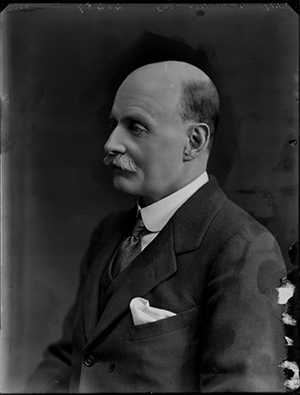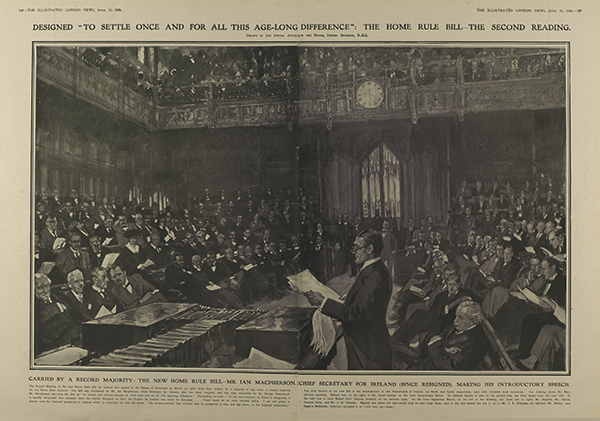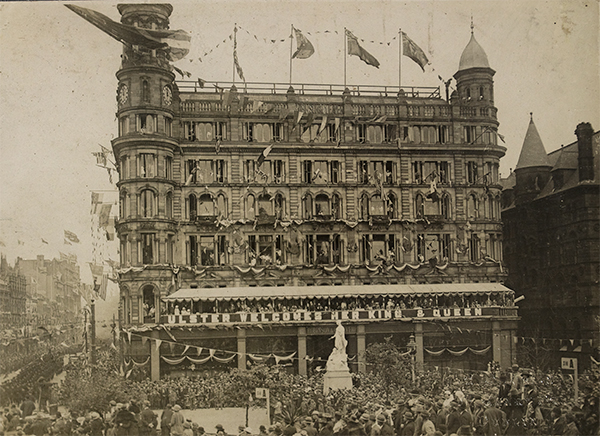The Government of Ireland Act 1920
Published in Features, Issue 6 (November/December 2020), Volume 28The British government’s commitment to Irish unity turned out to be illusory.
By Cormac Moore

Above: Walter Long—chaired the committee appointed by Lloyd George to draft the Fourth Home Rule Bill or Government of Ireland Bill.
The Government of Ireland Act 1920, which led to the partition of Ireland, had its genesis in the latter half of 1919, once most of the post-First World War peace conferences had concluded. The Third Home Rule Act had been on the statute book since 1914 and could no longer be postponed. To stop the act from coming into effect by default, the British prime minister, David Lloyd George, established a committee, chaired by Walter Long, to draft the Fourth Home Rule Bill or Government of Ireland Bill.
The Long Committee
Long was a staunch unionist and fervent anti-Sinn Féin cabinet member. Unsurprisingly, his committee was unionist in outlook. There was no nationalist representation whatsoever, nor were nationalists even consulted. The leading Ulster unionist, James Craig, and his associates were the only Irishmen consulted by the Long Committee during the drafting of the bill. The first meeting of the committee decided to create distinct legislatures for Ulster and the southern provinces, linked by a common Council of Ireland comprising twenty representatives from each parliament. This was the first time that a British government proposed a separate parliament for Ulster. Long’s committee envisaged that the Council of Ireland would lead to ‘the peaceful evolution of a single parliament for all Ireland’.
By offering nationalists far less than they demanded and Ulster unionists far more than they sought, the bill was clearly an attempt to solve the Ulster question, not the Irish question. Lord Birkenhead, one of the members of the Long Committee, admitted that they had no intention of placating Irish nationalists and that the bill was in many ways a tactical ploy, otherwise ‘I could not even be a party to making the offer’. Initially there were objections from Ulster. There was particularly a problem with the area to be included in the Ulster parliament. Ulster unionists sought the six counties of Antrim, Armagh, Derry, Down, Fermanagh and Tyrone rather than the nine counties of Ulster, as this was the maximum area that they felt they could dominate without being ‘outbred’ by Catholics. This decision was deeply unpopular amongst the 70,000 Protestants of Counties Donegal, Cavan and Monaghan, who were sacrificed to the southern administration. Thomas Moles MP explained that these three counties had to be abandoned in order to save the other six counties: ‘In a sinking ship, with life-boats sufficient for only two-thirds of the ship’s company, were all to condemn themselves to death because all could not be saved?’ The decision shattered any semblance of unity within unionism throughout Ireland.

Above: The passing of the second reading of the Government of Ireland Bill in the House of Commons on 31 March 1920. (Illustrated London News, 10 April 1920)
‘The Dismemberment of Ireland Bill’
The British government agreed to accede to the Ulster unionists’ wishes to confine the northern parliament to only six counties in the spring of 1920, just as the bill was being brought to the House of Commons. The Long Committee’s original argument that the nine-county proposal ‘will enormously minimise the partition issue’ because ‘it minimises the division of Ireland on purely religious lines’, meaning that ‘The two religions would be not unevenly balanced in the Parliament of Northern Ireland’, was exactly why the Ulster unionist leaders preferred six counties. They had no intention of minimising partition. By conceding to unionists’ demands the British government showed that their commitment to Irish unity was illusory.
Even though they endorsed the Government of Ireland Bill reluctantly, many Ulster unionists eventually concluded that the bill would cause the ‘least diminution of their Britishness’. It was a choice of the lesser of two evils. Some, like James Craig’s brother Charles, began to see the great benefits that Ulster unionists would garner from having their own parliament, saying that the bill ‘practically gives us everything that we fought for, everything we armed ourselves for’.
At the time there was no inevitability about the precise form of the Government of Ireland Bill or even whether it would be implemented. A great deal of confusion surrounded it. The Freeman’s Journal described it as a complex problem, considering that ‘the whole scheme of Irish administration is based on recognition of Ireland as a national entity with its centre in Dublin’, and derided it as ‘The Dismemberment of Ireland Bill’. Many in the civil service were reluctant to move to Belfast, uprooting their families and homes. George Chester Duggan, a civil servant who did move to Belfast, claimed that everyone in the civil service in Dublin ‘seemed to believe that the Government of Ireland Act in its present form would never become law, that something would happen to prevent the partition of Ireland’.

Above: ‘ULSTER WELCOMES HER KING & QUEEN’—crowds await the arrival of King George V in Belfast’s Donegall Square on the occasion of the opening of the Northern Ireland parliament in June 1921. (NLI)
Nationalists not consulted
As the Government of Ireland Bill was making its way through parliament, the British government was waging a war against Sinn Féin and its military wing, the IRA. Sinn Féin leaders stuck steadfastly and naively to the view that Ulster would readily come into an all-Ireland parliament once Britain was removed from the island. Tensions in Ulster also started to boil over. Waves of violence, much of it sectarian in nature, engulfed the north-east from the summer of 1920 to the summer of 1922, leading to the violent deaths of approximately 550 people. (See HI 28.5, Sept./Oct. 2020, pp 28–31.) Joseph Devlin, Irish Parliamentary Party MP for West Belfast, summed up the incredulity felt by many nationalists at the British government’s insistence on pushing through the bill whilst Ireland was in a state of unrest, with the vast majority of its people totally opposed to the proposed settlement. He accused the government of not putting ‘a single Clause … to safeguard the interests of our people’.
Instead of listening to Devlin or the people he represented, the British government took two steps in late 1920, on the advice of James Craig, that showed that it was in reality committed to partition. Before the Government of Ireland Bill even became law in December 1920, Craig’s proposals to commission a police force, the Special Constabulary, just for the area that would become Northern Ireland, and for the creation of the post of assistant under-secretary for the same area, were granted. The new assistant under-secretary, Ernest Clark, created the structures of a functioning government for when Northern Ireland came into being in the summer of 1921. Supported by a small team of no more than twenty, he worked from his appointment in September 1920 to set up the machinery of a new jurisdiction with very little to work with, as he testified: ‘I found myself … setting out to form a new “administration” armed only with a table, a chair and an Act of Parliament’.
May 1921 elections
It was in the atmosphere of war, sectarian hatred and boycotts that the bill became an act on 23 December 1920, and elections to the new parliaments were scheduled for the following May. Despite the substantial opposition to the act, the British government continued with its implementation. It came into effect on 3 May 1921, with elections for the two new parliaments held three weeks later. Although nationalists vehemently opposed the act, they still contested the election for the new jurisdiction of Northern Ireland. Áine Ceannt, widow of executed Easter Rising leader Éamonn, disagreed with this decision, claiming that, as Dáil Éireann was the only government she recognised, ‘no one else would order a general election’, certainly not the British government whip. Sinn Féin won six seats and the Nationalist Party also won six, unionists winning the other 40. All nationalists abstained from taking their seats in the new Northern Ireland parliament, granting unionists a monopoly on proceedings. For the Southern Ireland parliament, not one seat was contested. Sinn Féin secured 124 seats, a clean sweep except for the four Trinity College seats, electing a Second Dáil. Outside of Northern Ireland, the Government of Ireland Act 1920 was effectively ignored.
Notwithstanding the fanfare surrounding the occasion of the opening of the Northern Ireland parliament by King George V in June 1921, violence and the threat of violence permeated the new jurisdiction. Whilst hostilities eased in the south after the Truce of 11 July, the birth of Northern Ireland witnessed another wave of intense sectarian violence engulfing Belfast between June and August. It was a contested entity from the moment of its inception, ignored by the Catholic community, which comprised one third of the population.
Northern Ireland also had very limited powers. The northern domain had come into existence but it needed to be equipped with government services. The transfer of services was stalled owing to only one of the Irish jurisdictions being operational under the Government of Ireland Act 1920. The British government insisted that both Irish governments needed to be in place in order for this to happen, something that was acutely embarrassing for the northern government, which had no control over policing or over its laws.
By June 1921 the prime minister of Northern Ireland, James Craig, and his colleagues had achieved a number of key milestones that they believed had safeguarded their future of not being subservient to a Dublin parliament. The machinery of government was taking shape even without the required transfer of services. Despite the victories, the future of Northern Ireland as an entity was still not certain. This became clear once the British government began its negotiations with Sinn Féin following the Truce in July.
Treaty negotiations
During the Treaty negotiations between Sinn Féin and the British government from October to December 1921, the two primary issues discussed were Ulster and the Crown. The Irish were successful in reopening the Ulster Question, rekindling matters that unionists thought were settled. Lloyd George admitted that they had a weaker case on Ulster, stating that, ‘while British soldiers might die for the throne and empire, I do not know who will die for Tyrone and Fermanagh’.
Once the Irish delegation stated that their allegiance to Crown and Empire was contingent on Ireland’s ‘essential unity’, Lloyd George and others within the British government appeared open to changing Northern Ireland’s status if Sinn Féin would accept allegiance to the Crown. Lloyd George tried to pressure Craig into accepting an all-Ireland parliament, stating that ‘two dominions in Ireland was impractical and indefensible’. He was unsuccessful. Craig had become increasingly wary of Lloyd George since the latter’s similar suggestions in July of local autonomy for the north within a Dublin parliament, and he refused to concede any ground. Instead, he won a major victory when on 5 November Lloyd George agreed to transfer services to Northern Ireland without the existence of a government in the south. That Lloyd George, the wily negotiator, would grant concessions to Craig rather than obtain them suggests that his commitment to an all-Ireland solution was not wholly sincere. The Irish delegation were aware that the northern jurisdiction was not fully functioning when the conference began in October. The withholding of services by the British demonstrated that partition could be negotiable, but they appeared unaware of how to use this to their advantage. The significance of services being transferred to the north seemed lost on almost all those back in Dublin too.
With the avenue of reaching a settlement by pressurising Craig now closed, Lloyd George looked to squeeze the Sinn Féin delegation instead. His secretary, Tom Jones, dangled the idea of a Boundary Commission before Arthur Griffith and Michael Collins, Sinn Féin’s lead negotiators. Collins was against the proposal, as ‘it sacrificed unity entirely’. Griffith believed that there would be benefits to it and naively interpreted his assurances on the Boundary Commission as a ploy to help Lloyd George secure Irish unity. Instead, an animated Lloyd George used them against him as the negotiations reached their conclusion, leading to Griffith and the rest of the Irish delegation signing the Anglo-Irish Treaty on the morning of 6 December.
Article 12 of the Treaty
The Anglo-Irish Treaty’s main provision relating to Ulster was Article 12. This stipulated that if Northern Ireland opted not to join the Irish Free State, as was its right under the Treaty, the Boundary Commission would determine the border ‘in accordance with the wishes of the inhabitants, so far as may be compatible with economic and geographic conditions’. Central to the problem with the article was its ambiguity. No plebiscite was asked for and the clause was open to a number of different interpretations.
Ulster unionists were vehemently opposed to the Boundary Commission, despite Craig’s being one of the first to suggest such a concept during the embryonic stages of the Government of Ireland Bill in 1919. It reopened uncertainty and put Northern Ireland’s future in doubt, or at least significant parts of it. Nationalist leaders in the six and the 26 counties were overly optimistic, as it would transpire, concerning the outcomes that would be achieved from this Boundary Commission, believing that many areas in Northern Ireland would be transferred to the Irish Free State. This optimism in many ways explains the small fraction of time devoted to partition during the acrimonious Dáil debates over the Treaty. Even Éamon de Valera’s alternative proposal to the Treaty, Document No. 2, originally included the same clauses on the north as the Treaty. Nationalists’ hopes were ultimately shattered in late 1925, when the Boundary Commission report was shelved and the status quo of the border remained as it was, and as it does to the present day.
Cormac Moore is the author of Birth of the border: the impact of partition in Ireland (Merrion Press, 2019).
FURTHER READING
R. Fanning, Fatal path: British government and Irish revolution 1910–1922 (London, 2013).
P. Leary, Unapproved routes: histories of the Irish border 1922–1972 (Oxford, 2016).
R. Lynch, The partition of Ireland 1918–1925 (Cambridge, 2019).
















